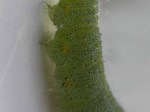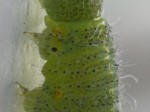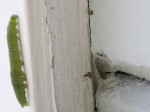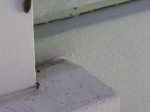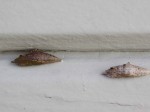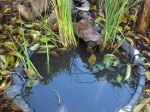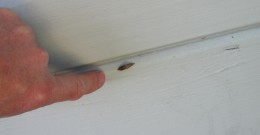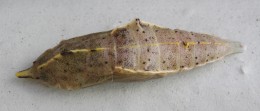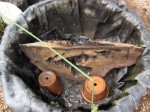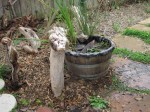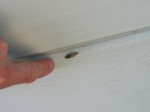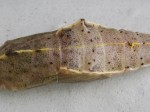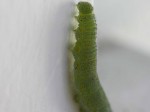
Garden Log:
1. Harvested a few purple potatoes from the Bog, a ditch that was filled with planting soil and potato starts in September.
2. Carried citrus to frost protection and illuminated Anna’s Avocado Aviary with a string of white decorative lights.
3. Photographed more caterpillar activity/crysalis formation on our home’s front door wall.
You, the Habitat Gardener:
1. The Bog is a low ditch in the middle of Dragon Spine Ridge in our back yard; it catches water from uphill. The Deva Tub drains directly to the Bog. The Deva Tub’s landscaped bowl — a lush horseshoe of fern, trumpet and jasmine vine, buddleia, ginger, forget-me-not, morning glory, rosemary, canna lily, and fig — also drains to the Bog. Good reason to use organic soap in Deva Tub, and not much of it! The Bog sure appreciates that soapy bath water during the summer and the many plants in the Bog willingly process the greywater. This year we decided to fill the Bog with soil and potato starts to grow potatoes during the dryer months.
During the wetter months, we want the Bog to collect storm water off the slight hill in our back yard. No problem, all we have to do is harvest the potatoes that have been enjoying the temporary planting bed in the Bog. The potatoes will go in our kitchen (or into cold storage) and the Bog’s planting soil will either go into bins for storage or into another planting bed. I bet some of it will go into the garlic bed we want to get started. Yes, we are running late. But we still have some garlic hanging in the kitchen from this fall’s garlic harvest and that can be used with the potatoes coming in now. Garlic potatoes from the garden — gardening has it’s rewards.
2. The string of 300 lights that we are using to minimize the frost damage on our avocado, paw paw, and guava trees use 61.2 watts — equivalent to a medium-sized light bulb. Not every night, just when the frost might be a bit too much for these young trees. Some day we will cut the cord (both electric and umbilical) and the more mature trees will be on there own. Yes, there will be some frost damage but the older trees will be able to recoup strength and leafage in the spring. Shutting off the string of lights after the morning’s warmth has arrived helps us minimize their electric use.
3. There’s been a lot of caterpillar activity on the front wall of our home while we have been warm and cozy inside (just minding our own business, I might add). As I mentioned in “Happy Thanksgiving weekend AND Saving a Pond” ( http://sporelore.com/residential-habitats/garden-pond/ ), these caterpillars are most likely coming to the wall for its warmth and shelter features. Lucky for us today, there was a yet-to-pupate caterpillar looking for its over-wintering site. A fresh, plump, partially transluscent light green caterpillar. Most likely by tomorrow it will have found a cozy nitch to set up camp for the winter.
Enjoy the pics. And if you know what type of caterpillar this is, please drop me a line.
- This active caterpillar has scaled the front wall of our home to window sill height.
- Note the skin’s expansion joints — the transluscent green bands not covered with hair or pigmented with spots like the outter skin.
- Bad hair day for Caterpillar but those hard wisks will keep some predators away. The hairs also most likely provide tactile feedback as Caterpillar crawls about. Gotta love those stubby legs!
- Nice vertical climb! Note the spider that has left its web to watch the parade float go by.
- Caterpillar on house siding. By tomorrow this caterpillar will deposit a silk pad to the house paint surface and secure itself to the pad.
- It’s a chrysalis race! The more colorful chrysalis on the left was probably established by a caterpillar yesterday; some of the caterpillar’s green skin is still visible. The sun-bleached model on the right was pupated 3 weeks ago, on November 26.
Tony

